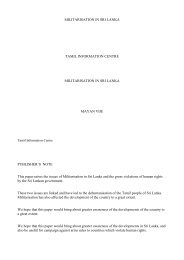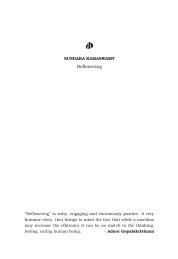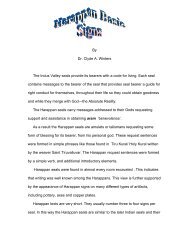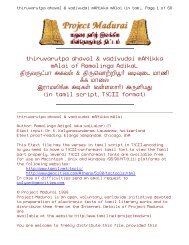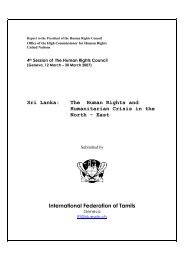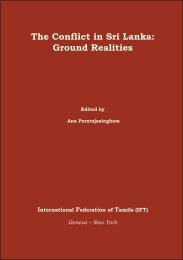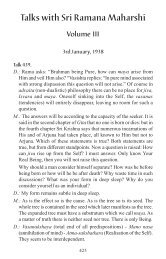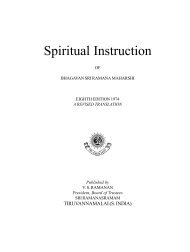Tamil Script Book: Learner's Manual - Sankaran Radakrishnan
Tamil Script Book: Learner's Manual - Sankaran Radakrishnan
Tamil Script Book: Learner's Manual - Sankaran Radakrishnan
Create successful ePaper yourself
Turn your PDF publications into a flip-book with our unique Google optimized e-Paper software.
<strong>Tamil</strong> <strong>Script</strong>/<strong>Sankaran</strong> Radhakrishnan<br />
Many of the poems in this collection seem to belong to the post-Sangham Age. It<br />
is widely accepted that among these, Thirukkural was composed before the<br />
second century CE. The Thirukkural consists of 1330 Kural, which are short<br />
verses of seven words. Thiruvalluvar is the author of this book. This book<br />
consists of three major divisions, namely, Arathuppal, Porutpal and Inbathupal.<br />
Arathupal deals with family life and ascetic life, which are called Illaram and<br />
Turavaram respectively. Perhaps this could be somewhat equated with the<br />
Sanskrit division Dharma (virtue). Porutpal deals with the rulers and the ruled<br />
and all the other aspects relevant to them. Perhaps this could be equated with the<br />
Sanskrit division Artha (meaning). Inbathuppal deals with love both premarital<br />
and extramarital. This could be somewhat equated with Kama (marital love). In<br />
short, Thirukkural is a very good guide for life and an excellent literary work to<br />
enjoy. This book has been translated into many Indian and foreign languages.<br />
The famous <strong>Tamil</strong> work Silappathikaram belongs to the later Sangam period.<br />
Saint Ilango, a Chera prince, wrote this epic. Silappathikaram is the story of a<br />
chaste woman, Kannaki. All <strong>Tamil</strong> people know the story of Kannaki. The<br />
author, Ilango, says in the prologue that the work is based on the truth that (i) a<br />
chaste woman is worthy of worship even by great people, (ii) the Aram (Dharma)<br />
becomes the destroyer of the kings who do injustice and (iii) the fate inevitably<br />
makes one to suffer the effect of one’s own actions. There is another epic known<br />
as Manimekalai by Sathnar, a contemporary of Saint Ilango. These two epics are<br />
known together as ’Twin Epics’.<br />
(ii) Bhakthi or Devotional Literature<br />
Bhakthi literature deals with religious philosophy, the history of saints, etc. Most<br />
of these are devotional poems. Religious teaching entered <strong>Tamil</strong> literature for the<br />
first time in Manimekalai. Sathanar the author of this book believed in<br />
Buddhism. The philosophy of Buddha is extensively discussed in Manimekalai.<br />
After the 7 th century CE, there was an acute fight between Saivites and Jainas as<br />
well as Saivites and Buddhists. The Nayanmars, the saints of Saivism, took many<br />
pains to spread and establish their religion all over <strong>Tamil</strong> Nadu. They were, to a<br />
great extent, successful in their attempt. Saivism as well as Vaishnavism clashed<br />
with Jainism and Buddhism. Consequently Jainism and Buddhism lost their<br />
ground in <strong>Tamil</strong> Nadu. Jains, Saivites, and Vaishnavites extensively used the<br />
medium of literature for the propagation of their religions. Sivagasinthamani is<br />
the outstanding work of Jains. Kambaramayanam is the most celebrated work of<br />
the Vaishnavites. Thiruvasakam is one of the most popular Saiva Bhakthi songs.<br />
Apart from these, there are many works for various religious groups.



